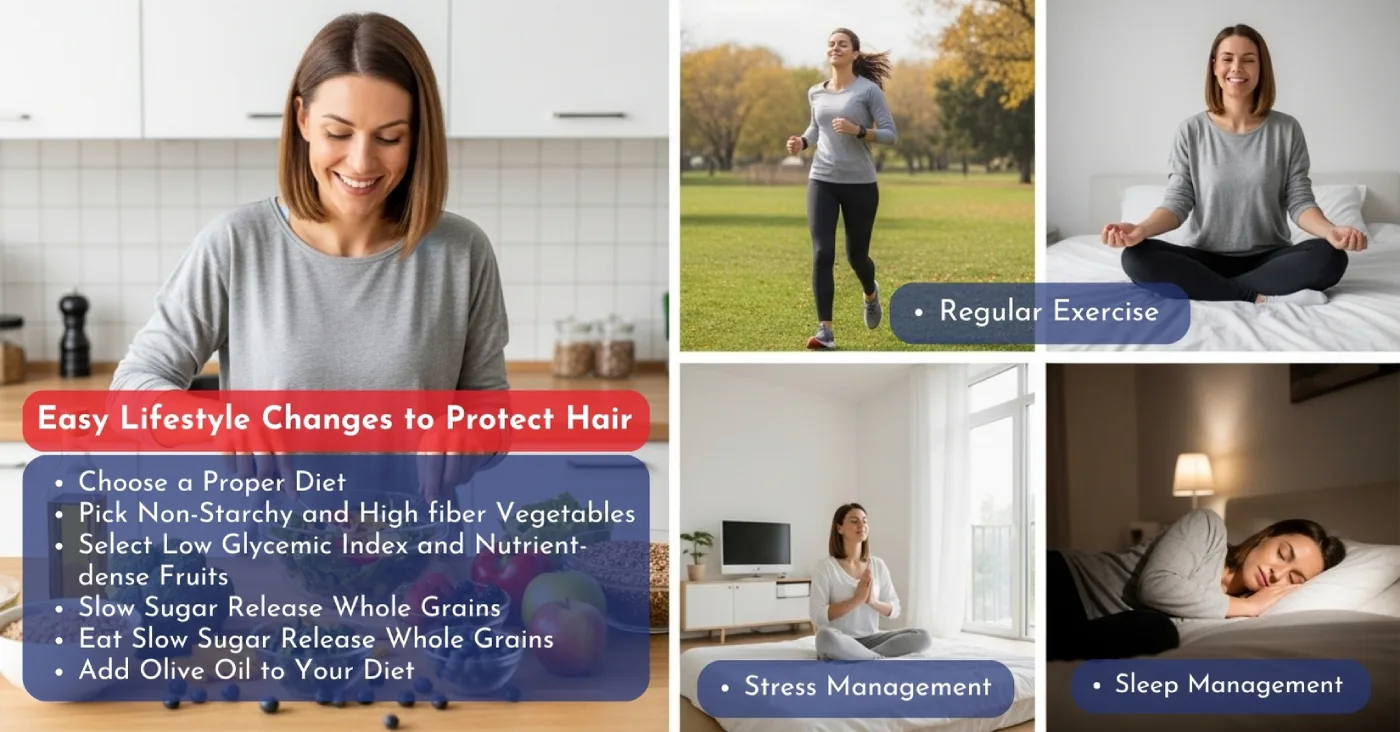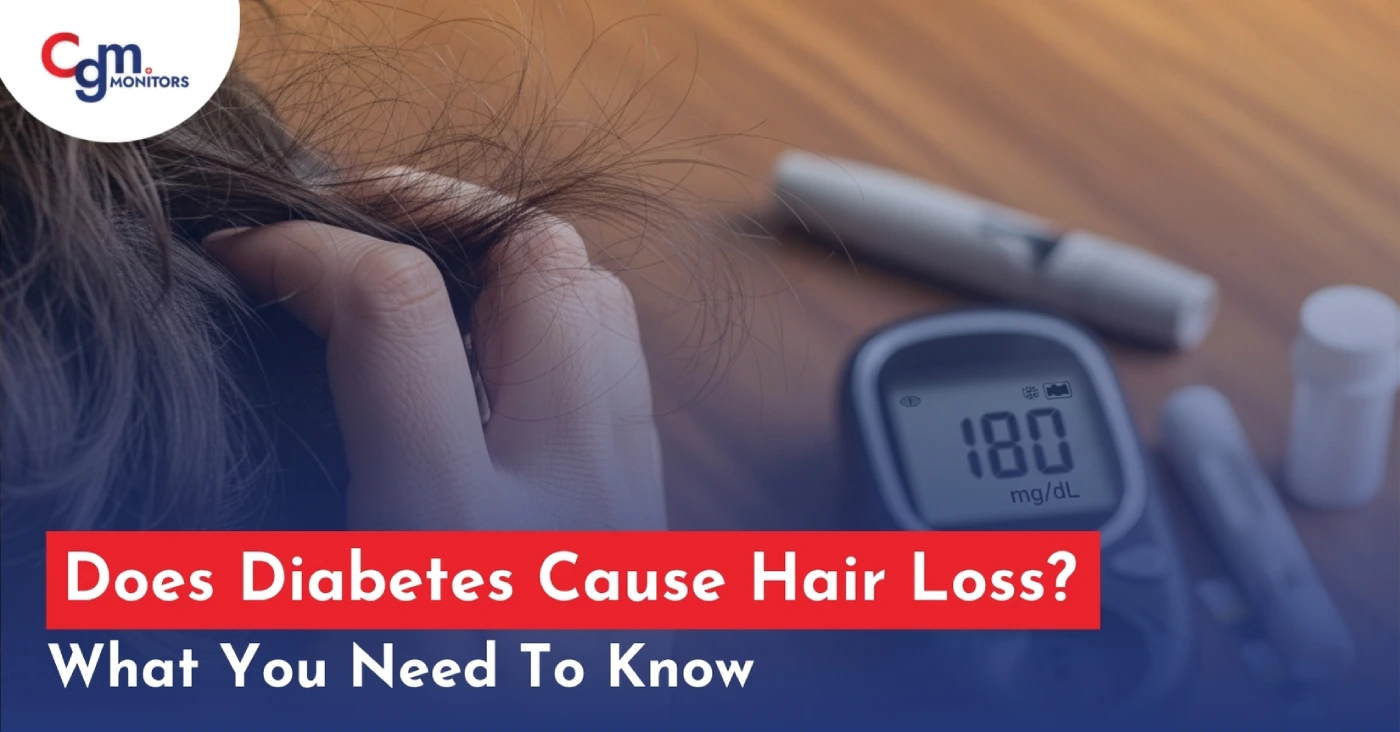Table of content
Diabetes is a mother of diseases can lead to various complications including kidney failure, vision loss, heart issues, including cardiac arrest, and more. But does diabetes cause hair loss? Yes, both type 1 and type 2 diabetes, as well as prediabetes, may trigger hair loss at a very young age. This is because hair health is linked to your complete metabolic health.
It’s always a good idea to visit a doctor, though, as there may be another cause behind your hair loss, and ignoring any underlying condition may be dangerous.
How Diabetes Can Lead to Hair Loss
Hair loss in diabetics is usually gradual but can worsen if blood sugar levels remain uncontrolled. The mechanisms include:
- Insulin resistance and hair loss: High insulin levels (common in type 2 diabetes and prediabetes) can disrupt hormone balance, reducing hair follicle growth.
- Poor blood circulation: Diabetes can damage blood vessels, leading to insufficient nutrients reaching hair follicles, especially in diabetes and hair loss on the legs.
- Inflammation: Chronic high blood sugar triggers systemic inflammation, which can stress hair follicles and trigger shedding.
- Autoimmune reactions: In type 1 diabetes hair loss, the immune system attacks insulin-producing cells and may also target hair follicles.
- Medication-related hair loss: Some diabetes medications, including metformin, rarely contribute to thinning hair. Patients often ask, does metformin cause hair loss? – it is uncommon but reported.
- Nutrient deficiencies: Poor glucose control can interfere with absorption of key nutrients like zinc, biotin, and vitamin D, all crucial for hair health.
Important: Women experiencing polycystic ovary syndrome (PCOS) should be tested for diabetes.
Type Of Diabetes Triggering Hair Loss
- Type 1 Diabetes Hair Loss: Autoimmune triggers make hair more vulnerable.
- Type 2 Diabetes Hair Loss: Often linked to insulin and hair loss via insulin resistance and hair loss.
- Prediabetes Hair Loss: Early-stage insulin resistance can also slow hair growth and increase shedding.
Even if you are prediabetic, taking steps early can prevent long-term hair damage.
Easy Lifestyle Changes to Protect Hair
Controlling blood sugar is the first step to reducing hair loss from diabetes. Consider these strategies:
Choose a Proper Diet
- Mediterranean diet: Rich in vegetables, fruits, whole grains, fish, and olive oil. Improves insulin sensitivity and reduces inflammation. Always pick a low-Glycemic index breakfast with high protein.
- Limit refined sugars and processed carbs: Prevents blood sugar spikes that worsen hair follicle stress.
- Include protein: Eggs, legumes, and lean meat support hair regeneration.
Does your blood sugar fluctuate often?
Using a continuous glucose monitor (CGM), such as Freestyle Libre 2 Plus Sensors, may help you monitor your glucose levels 24/7 without the need to repeat finger pricks.
Pick Non-Starchy and High fiber Vegetables
Aim for at least 2–3 cups per day, spread across meals. Key for blood sugar control and hair health:
- Leafy greens: Spinach, kale, Swiss chard, arugula
- Cruciferous veggies: Broccoli, cauliflower, Brussels sprouts
- Colorful veggies: Bell peppers, carrots, zucchini, eggplant
- Alliums: Garlic, onions (support circulation and antioxidant activity)
Tip: Rotate colors daily—more colors = more antioxidants for hair follicles.
Select Glycemic Index and Nutrient-dense Fruits
Fruits provide vitamins (like C and E) that support hair growth. Limit high-sugar fruits if blood sugar is elevated. Aim for 1–2 servings per day (1 serving = ~½ cup chopped fruit or 1 small fruit). Examples:
- Berries: Blueberries, strawberries, raspberries (excellent antioxidants)
- Citrus: Oranges, grapefruits, lemons (vitamin C supports collagen in hair)
- Stone fruits (moderation): Cherries, apricots, plums
- Apples and pears: High in fiber, slow sugar absorption
Avoid fruit juices—they spike glucose more than whole fruits.
Eat Slow Sugar Release Whole Grains
Choose 3–5 servings per day (1 serving ≈ ½ cup cooked). Examples:
- Quinoa
- Brown rice
- Oats (rolled or steel-cut)
- Barley
- Whole wheat pasta or whole grain bread
Tip: Pair grains with protein (eggs, yogurt, chicken) to reduce glucose spikes and support hair growth.
Add Olive Oil to Your Diet
Extra virgin olive oil is best for blood sugar regulation and circulation.
- Recommended amount: 1–3 tablespoons per day
- Usage examples:
– Drizzle over salads or steamed vegetables.
– Cook lean proteins (chicken, fish) with 1 tbsp olive oil.
– Use as a dip for whole grain bread instead of butter.
Olive oil’s monounsaturated fats help combat insulin resistance, which can indirectly reduce insulin resistance hair loss.
Claim your insurance or simply use your credit/debit card and buy your required CGM sensor from CGM Monitors today.
Regular Exercise
- Regular aerobic activity: Brisk walking or cycling 30 minutes daily improves insulin sensitivity.
- Strength training: Helps reduce insulin resistance and supports metabolic health.
Tip: In case you have trouble even during walking, you may divide it in short laps.
Proper Sleep
7–9 hours per night of core sleep supports hormonal balance, which affects hair growth cycles.
Did you know?
Studies suggest that sleeping late and at inconsistent times have adverse impacts on health. Try maintaining consistent sleep cycles and avoiding staying up late at night, as they may support your overall health.
Stress Management
- Mindfulness and meditation: Chronic stress increases cortisol, which can accelerate female diabetes hair loss.
- Yoga or light stretching: Reduces stress and supports circulation to hair follicles.
Combined, these lifestyle steps can help control blood sugar and reduce hair loss from diabetes for type 1, type 2, and prediabetic patients.

Supplements That May Prevent Hair Loss & Support Diabetes Management
Certain nutrients may support hair health in diabetics:
- Biotin: Supports hair strength and growth.
Naturally Sources: Whole eggs, nuts like walnuts, cauliflower, avocado, and fish, particularly fatty ones like tuna and salmon. - Zinc: Deficiency linked to hair thinning.
Naturally Sources: Oysters (contains the most zinc, i.e., 32mg/3 ounces), beef, legumes, seeds (such as pumpkin seeds), nuts, and more. - Vitamin D: Low levels correlate with autoimmune-related hair loss.
Naturally Sources: Sun, Fatty fish, beef liver (may not be suitable during pregnancy), egg yolks, and more. - Omega-3 fatty acids: Reduce inflammation and improve scalp health.
Naturally Sources: Flaxseeds, chia seeds, nuts, fish, and more. - Chromium and magnesium: Help regulate blood sugar, indirectly supporting hair growth.
Naturally Sources: Meat, fish, cereals, pulses, vegetables, grape juice, orange juice, and more.
As highlighted by the Cleveland Clinic, chromium supplements are associated with some side effects, such as headaches, mood changes, stomach and sleep issues. Always consult your doctor before starting supplements, especially if on diabetes medication.
Medical Approaches for Controlling both Diabetes & Hair Loss
- Blood sugar control: Optimizing insulin and glucose levels is essential.
- Topical treatments: Minoxidil may help in some cases of hair loss from diabetes.
- Regular dermatology check-ups: To rule out other causes such as thyroid disease or alopecia areata.
Conclusion
Diabetes can trigger hair loss; however, it’s a gradual loss and may be treated with the help of correct lifestyle changes, which include diet (mediterranean diet), sleep (consistent sleep timing may help), exercise (even a brisk walk may help), and stress management – complete details are added above.
Monitoring your blood sugar levels and making decisions accordingly is the key here. Individuals frustrated of repeated finger pricks may find it useful to try continuous glucose monitors, known as CGMs.
Disclaimer: This blog is for informational purposes only and does not constitute medical, legal, or professional advice. While we strive for accuracy, errors or omissions may occur.
Some images in this blog may be AI-generated or for illustrative purposes only. Device images belong to their respective manufacturers and are used here for reference. Actual products may vary.







Write a comment
Your email address will not be published. All fields are required